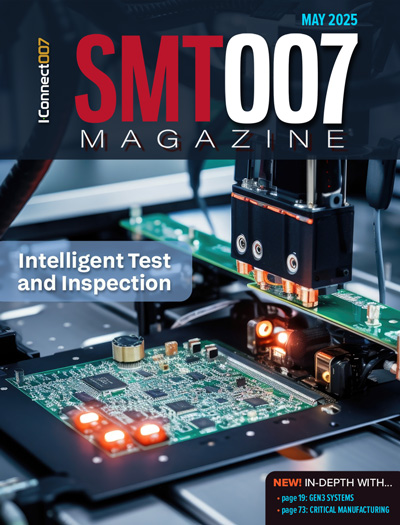-

-
News
News Highlights
- Books
Featured Books
- smt007 Magazine
Latest Issues
Current Issue
What's Your Sweet Spot?
Are you in a niche that’s growing or shrinking? Is it time to reassess and refocus? We spotlight companies thriving by redefining or reinforcing their niche. What are their insights?

Moving Forward With Confidence
In this issue, we focus on sales and quoting, workforce training, new IPC leadership in the U.S. and Canada, the effects of tariffs, CFX standards, and much more—all designed to provide perspective as you move through the cloud bank of today's shifting economic market.

Intelligent Test and Inspection
Are you ready to explore the cutting-edge advancements shaping the electronics manufacturing industry? The May 2025 issue of SMT007 Magazine is packed with insights, innovations, and expert perspectives that you won’t want to miss.
- Articles
- Columns
- Links
- Media kit
||| MENU - smt007 Magazine
Localized Contamination Can Cause Big Problems
July 30, 2015 | Terry Munson, Foresite Inc.Estimated reading time: 2 minutes
In today's electronics manufacturing environment, assemblers continue to overlook areas of localized contamination that are capable of causing product failures. By neglecting to examine especially sensitive, critical, or tightly packed areas on an assembly, opportunities for electrochemical failures loom.
The following case study involves a customer seeing visible, white residue and dendritic growth in a connector area. Fortunately, the residue was visible, which alerted them to investigate the source and implications of the residue. Often, residues are invisible and can go unnoticed until field problems occur.
Case study
One assembly sample was sent to our laboratory for analysis to help troubleshoot this problem. In this project, we utilized FTIR, SEM/EDX and ion chromatography (IC) analyses. FTIR only identified flux residues. SEM/EDX revealed concentrations of tin, lead, oxygen and copper.
We concluded, due to the high concentrations of tin and lead, that electromigration was occurring in this area, creating the visible white residue and dendritic growth. Based on this finding, we analyzed the white residue area with IC using C3 (Critical Cleanliness Control) in order to identify the contaminants present and to better understand the impact of the manufacturer's processes.
The C3 enabled us to extract residue samples from 0.1 in2 areas on both the connector and its casing, plus reference areas near both sites. The C3 quickly showed "Dirty" test results for the connector and casing areas with the white residue. Tests on the connector and casing reference areas (no visible white residue) with the C3 read "Clean". IC analysis on these four C3 localized extractions indicated high levels of chloride, sulfate and weak organic acid (WOA) flux residues on the two areas with white residue; low, acceptable levels of ionic residue species on the two reference area samples.
Conclusions
We suspected that an external fluid contaminant had been introduced to the assembly at some point, causing the white residue and dendrites. Visual inspection of the board revealed that the white residue was in a line, suggesting a drip—possibly caused by tap water, which tends to be high in chloride and sulfate.
Recommendations
We recommended to this customer to monitor their processes, especially looking for the source of an external fluid contaminant—the cause of this reliability issue.
This is just one of numerous cases we have seen in our lab that demonstrate the importance of evaluating the cleanliness of specific, local areas of the board and/or assembly. Since the tested reference areas were acceptably clean and the vast majority of the assembly was free of the visible residue, standard industry test methods (bulk extraction), such as ROSE testing, would not identify specific, potential problem areas – the test result is an average cleanliness level for the entire assembly.
With passing (ROSE) test results, the presence of the white residue could be interpreted as not threatening product reliability – a benign situation. Actually, the residue in this case was highly corrosive and already causing product problems that would only intensify in use. Localized extraction methods can lead to identification of problem areas in an assembly, even before residues become visible or dendrites appear.
The C3 automatically, as part of a programmed cycle, extracts a sample from a selected, small (0.1 in2), product location of interest. Localized extraction is a significant advancement in electronics manufacturing quality control.
Terry Munson is the founder and president of Foresite Inc. Terry has extensive experience with how cleanliness issues are affecting product reliability for electronic hardware. He is the primary developer of ion chromatography analysis for use in the electronics manufacturing industry and is an active member in the IPC.
Suggested Items
IPC Hall of Fame Spotlight Series: Highlighting Lionel Fullwood
07/15/2025 | Dan Feinberg, I-Connect007Many IPC members who have contributed significantly to IPC and our industry have been awarded the IPC Raymond E. Pritchard Hall of Fame (HOF) Award. Though many early HOF members have passed away and are unknown to today’s IPC membership, their contributions still resonate. This special series on IPC Hall of Fame members provides a reminder of who was honored and why. As a bonus, for those who are still around, we get to find out what these talented individuals are up to today.
TRI Unveils New Platform for Diverse Board Sizes Search Submit
07/14/2025 | TRITest Research, Inc. (TRI), the leading test and inspection systems provider for the electronics manufacturing industry, proudly introduces a new size configuration for SPI and AOI Models.
Seeing a Future in Mexico
07/09/2025 | Michelle Te, I-Connect007The Global Electronics Association (formerly known as IPC) has been instrumental in fostering a partnership with Guanajuato, a state north of Mexico City with 12 industrial clusters and close to 150 companies involved in electronics. This past spring, Alejandro Hernández, the undersecretary for investment promotion in Guanajuato, attended IPC APEX EXPO 2025 at the invitation of IPC Mexico Director Lorena Villanueva, where he met with several companies to discuss the opportunities available in Mexico. He is inviting electronics-related companies seeking long-term investment in a centrally located area with access to highways, railways, and ports.
The Global Electronics Association Releases IPC-8911: First-Ever Conductive Yarn Standard for E-Textile Application
07/02/2025 | Global Electronics AssociationThe Global Electronics Association announces the release of IPC-8911, Requirements for Conductive Yarns for E-Textiles Applications. This first-of-its-kind global standard establishes a clear framework for classifying, designating, and qualifying conductive yarns—helping to address longstanding challenges in supply chain communication, product testing, and material selection within the growing e-textiles industry.
IPC-CFX, 2.0: How to Use the QPL Effectively
07/02/2025 | Chris Jorgensen, Global Electronics AssociationIn part one of this series, we discussed the new features in CFX Version 2.0 and their implications for improved inter-machine communication. But what about bringing this new functionality to the shop floor? The IPC-CFX-2591 QPL is a powerful technical resource for manufacturers seeking CFX-enabled equipment. The Qualified Product List (QPL) helps streamline equipment selection by listing models verified for CFX compliance through a robust third-party virtual qualification process.


